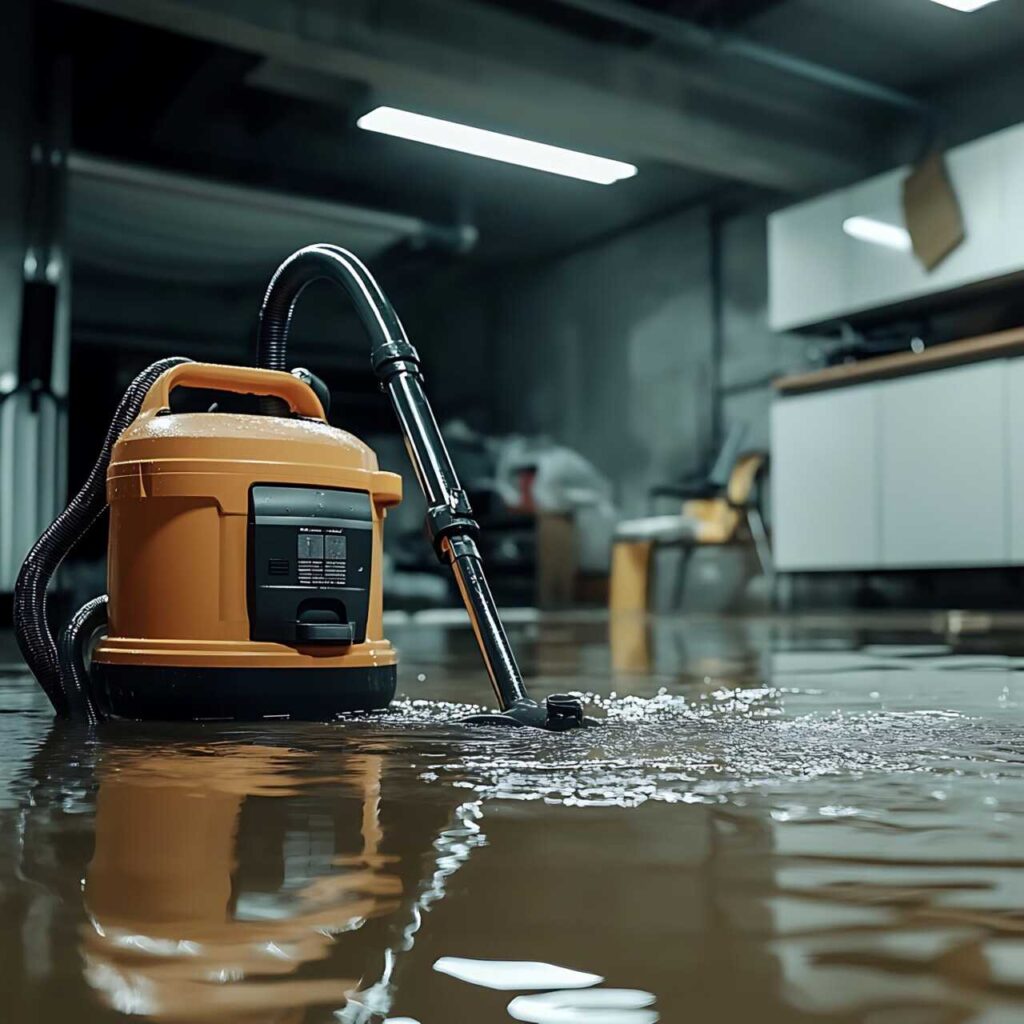
Contents
When it comes to flood damage, speed is essential, but so is precision. The right water extraction tools can make all the difference in recovery efforts. You’ll find that certain equipment excels in specific situations, from rapid water removal to moisture control. Understanding which tools to use can greatly impact the effectiveness of your remediation process. Let’s explore the top seven tools that can aid you in restoring affected areas efficiently.
Key Takeaways
- Submersible pumps are ideal for deep water removal, featuring automatic float switches for hands-free operation and high discharge capacity for efficiency.
- Wet/dry vacuums offer versatility for extracting both water and debris, with powerful suction and larger tanks to reduce emptying frequency.
- Water extraction machines provide powerful suction and portability, suitable for various job sizes, from small residential to large-scale flood recovery.
- Portable flood extractors maximize water removal with high-performance motors and lightweight designs, making them easy to maneuver in affected areas.
- Consider safety gear and local regulations when selecting tools, ensuring safe operation and proper disposal of extracted water.
Submersible Pumps
Submersible pumps are essential tools for efficiently removing water during flood damage recovery. These pumps are designed to operate underwater, making them highly effective for dewatering basements, flooded yards, or other submerged areas.
You’ll find that they come in various sizes and power levels, allowing you to choose the right one based on the volume of water you need to remove.
When using a submersible pump, verify it’s properly submerged and connected to a reliable power source. Many models feature an automatic float switch, which activates the pump when water levels rise, providing a hands-free solution.
Additionally, check the pump’s discharge capacity, as higher rates can appreciably reduce the time spent on recovery.
Wet/Dry Vacuums
Wet/dry vacuums are versatile tools that play an essential role in flood damage recovery.
These machines efficiently remove water from various surfaces, making them invaluable for homeowners facing waterlogged situations. You’ll appreciate their ability to handle both wet and dry debris, which can save you time and effort.
Here are a few key features to take into account when choosing a wet/dry vacuum:
- Powerful Suction: Look for a high horsepower rating to ensure effective water extraction.
- Capacity: Select a model with a large tank to minimize emptying during use.
- Portability: Opt for vacuums with wheels or handles for easy maneuverability around your property.
Water Extraction Machines
When dealing with flood damage, understanding the various types of water extraction machines is essential for efficient recovery.
You’ll want to evaluate key features like pump capacity, suction power, and portability to select the right equipment.
This knowledge will help you effectively address the specific needs of your situation.
Types of Extraction Machines
Understanding the different types of water extraction machines is essential for effective flood damage remediation. Each type serves a unique purpose, catering to various needs during the extraction process.
Here are three common types you should consider:
Portable Extractors: Ideal for small to medium jobs, these machines are easy to maneuver and perfect for residential areas.
Truck-Mounted Extractors: Designed for large-scale operations, these powerful units can handle extensive flooding situations with efficiency.
Submersible Pumps: Best for deep-standing water, these pumps effectively remove large volumes quickly, ensuring thorough extraction.
Choosing the right machine speeds up the cleanup process and helps prevent further damage.
Equip yourself with the appropriate tools, and you’ll be well on your way to successful flood damage recovery.
Key Features to Consider
Choosing the right water extraction machine involves evaluating several key features that directly impact efficiency and effectiveness.
First, consider the pump capacity; a higher GPM (gallons per minute) rating means quicker water removal.
Next, look at the vacuum strength; machines with high inches of mercury (inHg) ratings extract moisture more thoroughly.
Portability matters, too—select a lightweight model with sturdy wheels for easy maneuverability.
Also, check for additional features like built-in heaters or auto shut-off functions, which enhance performance and safety.
Finally, assess the tank size; larger tanks reduce the frequency of emptying during operation.
Portable Flood Extractors
Portable flood extractors are essential tools for quickly removing excess water from affected areas, minimizing damage, and reducing recovery time.
These units are designed for efficiency and ease of use, making them an invaluable asset for anyone facing flood damage.
When selecting a portable flood extractor, consider these key features:
- Powerful suction: Look for models with high-performance motors to maximize water removal.
- Lightweight design: A compact extractor allows for easy maneuverability and transport, especially in tight spaces.
- Versatile attachments: Different nozzle options and hoses can help you tackle various surfaces and hard-to-reach areas.
Truck-Mounted Water Extraction Units
Truck-mounted water extraction units offer high-efficiency performance, making them essential for rapid flood response.
Their design allows for versatile application uses, from residential areas to large commercial spaces.
You can rely on these units to effectively manage water removal tasks in various environments.
High Efficiency Performance
When tackling flood damage, utilizing high-efficiency performance water extraction units can greatly expedite the recovery process.
These truck-mounted systems are designed to handle large volumes of water quickly, markedly reducing downtime.
You’ll appreciate their ability to:
Increase extraction speed: Powerful pumps allow for rapid water removal, minimizing the risk of secondary damage.
Enhance recovery effectiveness: Advanced filtration systems ensure thorough extraction, leaving surfaces dry and ready for restoration.
Improve operational efficiency: Integrated designs mean less setup time and reduced labor costs, making your efforts more productive.
Versatile Application Uses
While flood damage recovery is a primary function, truck-mounted water extraction units also excel in various other applications.
You’ll find these units invaluable for tasks like sewage cleanup, where quick and efficient removal is vital. They’re also perfect for construction sites, effectively managing water accumulation to maintain a safe working environment.
When dealing with natural disasters, these units can assist in rapid response efforts, helping communities recover faster.
Additionally, you can use them in agricultural settings for irrigation management and to mitigate water-related damage to crops.
Their versatility makes them essential in multiple industries, ensuring you’re equipped to tackle any water extraction challenge with ease and efficiency.
Infrared Moisture Meters
Infrared moisture meters are essential tools in evaluating flood damage, as they allow you to quickly detect moisture levels in various materials without causing any disruption.
These devices use infrared technology to measure surface temperatures and estimate moisture content, making them invaluable in restoration efforts.
Here’s what you’ll appreciate about infrared moisture meters:
Non-invasive measurements: You can assess moisture without damaging walls or flooring.
Quick results: They provide immediate feedback, helping you make informed decisions on water extraction.
Versatile application: Ideal for various materials, including wood, drywall, and concrete.
Using an infrared moisture meter streamlines your assessment process and enhances your ability to communicate findings with team members or clients.
You’ll feel more confident in your restoration efforts, knowing you have accurate data at your fingertips.
Investing in this tool is a smart choice for effective flood damage evaluation.
Dehumidifiers
Dehumidifiers play an essential role in flood damage restoration by efficiently removing excess moisture from the air and surfaces.
When you’re dealing with water damage, maintaining ideal humidity levels is vital to prevent mold growth and structural damage. Portable and industrial dehumidifiers are available, each suited for different environments.
To select the right one, consider the size of the affected area and the severity of moisture. High-capacity units work best in large spaces, while smaller models can manage localized issues.
Set the dehumidifier to the desired humidity level, typically between 30% and 60%, for effective moisture control.
Regularly monitor the unit’s water collection tank and empty it as needed, or opt for continuous drainage for convenience.
Summary
In the aftermath of a flood, having the right tools at your disposal can transform chaos into order. By utilizing submersible pumps, wet/dry vacuums, and portable extractors, you’ll swiftly reclaim your space from the clutches of water. With truck-mounted units and dehumidifiers, you can tackle larger areas while infrared moisture meters guide your every step. Embrace these essential tools to navigate the recovery process and restore your environment to its former glory, ensuring a brighter, drier future.
Recent Posts
Your Trusted Guide to Flood Damage Repair
It’s essential to act quickly and methodically to mitigate any further issues from flood damage.
Comprehensive Flood Damage Repair Process Explained
Flood damage repair can seem like an insurmountable task, but it’s important to tackle it
What Is the Step-by-Step Flood Damage Repair Process?
When you face flood damage, evaluating the damage, extracting water, and drying the area are
